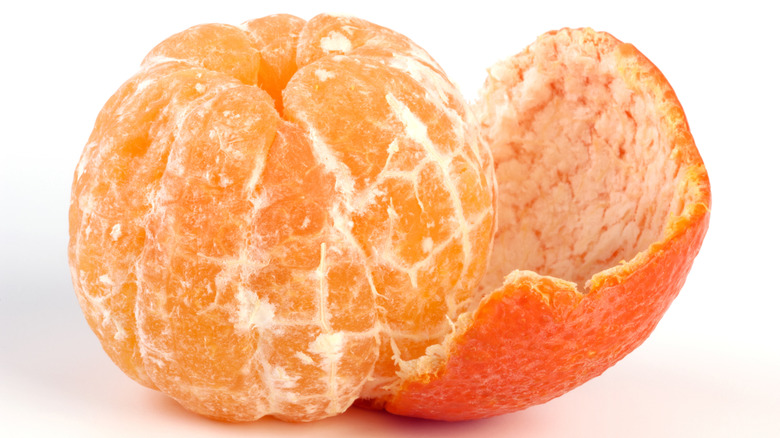Finally, An Answer For What That White Spongy Stuff On Peeled Oranges Is
Imagine digging into a fresh juicy orange. You tear the skin off — maybe in one peel, if you're especially talented — and you take a bite into the ripe orange flesh, almost instantly getting that refreshing, tangy burst of orange juice. But you get something else too — the white stringy "webbing" that clings to the exterior of the orange flesh. As you pick strands of it out of your teeth, you might wonder what it could possibly be.
That stringy white webbing is actually known as pith. Aside from being kind of annoying if it gets stuck in your teeth, pith is completely safe to eat and can be consumed without any detrimental effects. It's not just oranges you'll find this spongey film on, either. If you've ever peeled lemons, limes, or any other citrus fruit, you've probably seen more than your fair share of pith. But now that we have a name for it, what exactly is it anyway?
Pith, surprisingly enough, isn't just residue or the interior of the orange peel. It's actually the orange's connective tissue, a complex webbing of fibers that hold the flesh of the orange and the bright orange peel together. If you've ever wondered what oranges and human skin have in common, it's that they both have some form of connective tissue. Even more surprising is that this connective tissue is actually said to have some pretty impressive health benefits outside of its chewy and flavorless texture.
The pith of an orange is actually pretty nutritious
Most of the time, if you're eating an orange or a clementine, you probably toss the white stringy pith alongside the crumpled remains of the orange peel. While this is likely more out of habit than anything, you should consider eating the pith alongside the orange. It may come as a surprise, but the pith can actually be very healthy.
The pith, although relatively tasteless and more chewy than anything else, is actually very high in fiber and contains a surprisingly high amount of vitamin C. In fact, the pith alone contains nearly as much vitamin C as the orange itself does. It is also high in assorted flavonoids, which may be able to improve blood vessel health and reduce inflammation, per the American Heart Association. According to Andrew Weil, M.D., Other flavonoids found in the pith can also have antioxidant properties and even help to reduce the absorption of carbohydrates in your intestinal tract. In short, the pith isn't harmful to consume and can in fact be very beneficial to your health.
Now should you eat the pith on its own? Not unless you really want to, of course. It's best to eat the pith alongside the fruit itself as you eat it — not just for the combined dose of vitamins and minerals, but because it'll be much easier to enjoy than eating the pith tissue on its own.
Even the orange peel can be good for you
It would probably be strange to see someone take a bite out of an orange, peel and all, as if they were biting into an apple. While you usually don't eat the orange peel, this often-discarded part of the orange can also be very healthy for you.
The orange peel is not only full of several nutrients like fiber and certain plant compounds, but much like the pith and the flesh, it's also filled with vitamin C. In fact, 1 tablespoon of orange peel is enough to satisfy 14% of your daily intake of vitamin C. But while the orange peel does have several nutritional benefits, the biggest obstacle to enjoying said benefits is how to actually consume the peel.
If you want to try incorporating orange peel into your diet, it's better to start off small than it is to jump right into it. Some very simple methods to include orange peel in your diet are chopping the peels into very small bits and using them in smoothies, adding the peel to salads, or even making it into a delicious candied treat. If you try to consume raw orange peel all at once, there's a chance you'll make yourself sick, so you're better off starting off slow.


